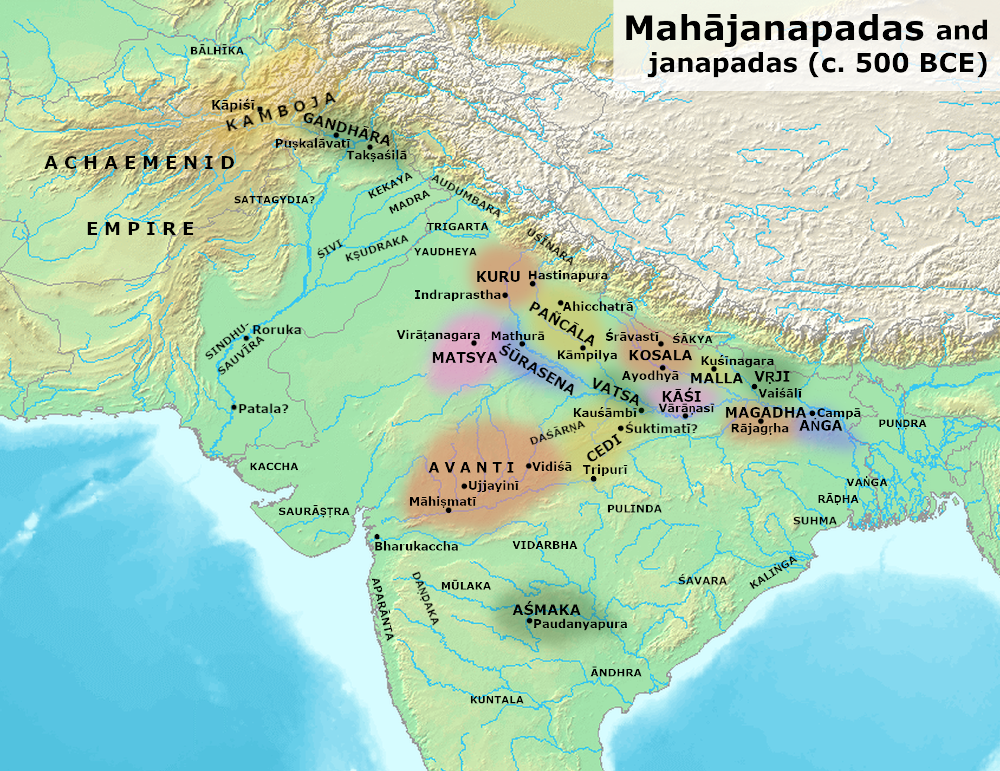Magadha Empire
The Magadha Empire was located in the eastern part of India, arising in the kingdom of Magadha around 600 BC. At its greatest extent, it encompassed most of the Indian subcontinent including parts of modern day Bangladesh, India, Nepal, and Pakistan.
Who were the early rulers of the Magadha Empire?
Some early rulers of the Magadha Empire were Bimbisara, Ajatasatru, Udayin, and the Nanda dynasty which included Mahapadma Nanda and his sons. These kings ruled in succession, expanding Magadha’s control over neighboring territories through a combination of diplomacy, marriage alliances, and military campaigns.
How did the Magadha Empire gain power and expand its territory?
The Magadha Empire gained power due to its strategic location in the fertile Ganges river valley, agricultural surplus, mining of natural resources, and new administrative principles. It expanded territorially by conquering nearby kingdoms and tribal territories under the leadership of aggressive rulers using its powerful army and diverse strategies.
What were some key policies and principles of governance in the Magadha Empire?
Important policies included centralized administration and bureaucracy, efficient taxation and surplus distribution, development of infrastructure, standardization of weights and measures, and establishment of a large espionage system. Key principles included reliance on native Indian methods along with absorbing outside influences and technology.
What new administrative principles did the Magadha Empire pioneer in ancient India?
The Magadha Empire pioneered new principles like centralized governance, bureaucratic administration, efficient taxation, standardization of policies, investment in infrastructure like irrigation for economic growth, appointment of state officers for law and order, and a large espionage system.
What were some notable cultural achievements under the Magadha Empire?
The Magadha Empire saw advancements in philosophy under the Ajivika and Charvaka schools of thought. Educational institutions like Taxila and Nalanda thrived. Stone sculpting and temple architecture became sophisticated as seen in early Buddhist architecture. Trade ties led to influences from Persia.
How did religion develop under the Magadha Empire?
Major Indian religions like Buddhism, Jainism and Hinduism developed and expanded during the Magadha Empire which actively supported and promoted religious movements. Buddhist principles and institutions gained royal patronage under Ashoka Maurya later.
Who was Ashoka Maurya and why was he significant?
Ashoka Maurya, grandson of Chandragupta Maurya, ruled one of the largest empires across South Asia and Afghanistan after conquering Kalinga. He converted to Buddhism following this conquest, later promoting Buddhist principles of non-violence, tolerance and dhamma throughout his empire.
How did the invasion of Alexander the Great impact the Magadha region?
Though Alexander turned back at the Beas River, the threat of his invasion led future Magadhan rulers like Chandragupta Maurya to expand a powerful empire across the northwest frontiers, as well as maintain strong armies and adaptive policies to counter any future invasion.
Why did the Magadha Empire decline?
The Magadha Empire ultimately declined due to decay of central administrative institutions, weak rulers, succession disputes, strained resources due to constant defense needs, the growing powers of provincial governors, internal rebellions and external invasion by the Indo-Greeks.
What were some key geographic features of the Magadha region that allowed it to gain dominance?
The Magadha Empire arose in the fertile Ganges river valley with abundant water supply and agricultural surplus. Its location inland gave it protection from coastal attacks. Its proximity to key trade routes, iron ore deposits and gold mines also gave it strategic control over resources.
How did rulers like Bimbisara and Ajatasatru expand Magadha territories?
Rulers like Bimbisara cemented control through marriage alliances. His son Ajatasatru aggressively expanded through conquest of neighboring states like Anga, strengthening the army’s cavalry, infantry, chariots and navy to defeat regional rivals.
What were the causes for the conflict between Magadha and the Vajji confederacy?
There was prolonged conflict between Magadha and the Vajji confederation to the north over control of the strategic river trade routes. Magadha sought to control trade and transportation while the Vajjis wanted autonomy in the region.
How did Magadhan military strategy and policies evolve over time?
Earlier Magadhan armies relied on infantry, chariots and cavalry. Later, there was emphasis on expanding military strategy using innovation, technology, productive military cantonments and training camps, while adapting tactics from invaders like Alexander.
What kind of civil code and legal principles did the Magadha Empire follow?
Laws were based on Hindu scriptures and texts like the Dharmashastras. Legal principles emphasized royal duty, ethical governance and strict adherence to just laws. Customary laws were codified and early legal texts defined rules, regulations and punishments.
How did the Magadha Empire promote trade, commerce and urbanization?
It invested in infrastructure like roads, irrigation and ports to facilitate trade and commerce domestically and overseas, leading to urbanization and rise of cities like Pataliputra and Rajgir as key hubs for the developing economy.
What architectural features defined the Maurayan period structures and buildings?
This era saw development of polished stone architectural styles seen in pillars, palaces and monuments; artisans skilled in stone sculpting and carving; construction of many Buddhist monasteries, stupas and sanchi pillars; and influence of Persian styles.
What are some of Emperor Ashoka’s most notable edicts and policies?
Some of Ashoka’s notable policies included banning enslavement, animal cruelty, violent punishments while promoting tolerance, welfare, tree planting, health care, religious freedom and education. His edicts were publicly and widely proclaimed on specially erected pillars and rocks across India.
How did Chandragupta Maurya consolidate control over Central and Northwest India?
Chandragupta consolidated control by eliminating Greek garrisons, establishing a complex bureaucratic structure with central authority, governance innovations and support from Chanakya while spreading cultural assimilation of conquered lands to unify the empire.
Why is the detailed documentation of events and administration of the Magadha Empire patchy and inconsistent at times?
Much information comes from secondary sources written centuries later. Original contemporaneous accounts were destroyed over successive invasions and damage to libraries and monuments. Systematic recording procedures were also lacking compared to later empires.


